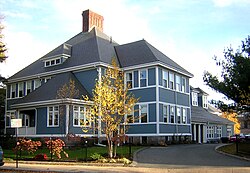This article has multiple issues. Please help improve it or discuss these issues on the talk page . (Learn how and when to remove these messages)
|
| The Woodward School | |
|---|---|
 | |
| Address | |
 | |
1102 Hancock Street , 02169 United States | |
| Information | |
| Former names | Woodward Institute for Girls, Woodward Female Institute, Woodward School for Girls |
| Type | Private school |
| Motto | Discimus ut Ducamus (We Learn So That We May Lead) |
| Opened | 1894 |
| Founder | Dr. Ebenezer Woodward & Mary A.W. Greenleaf Woodward |
| CEEB code | 221810 |
| NCES School ID | 00604829 |
| Head of school | Alex Magay |
| Grades | 6-12 |
| Gender | Female |
| Campus | Urban |
| Color(s) | Maroon and White |
| Athletics | Soccer, Basketball, Softball, Volleyball |
| Athletics conference | New England Preparatory School Athletic Council (NEPSAC) |
| Mascot | Wildcat |
| Accreditation | New England Association of Schools and Colleges (NEASC) |
| Newspaper | The Columns |
| Affiliation | International Coalition of Girls' Schools (ICGS) |
| Website | thewoodwardschool |
Woodward Institute | |
| Location | 1102 Hancock Street, Quincy, Massachusetts 02169 |
|---|---|
| Coordinates | 42°15′18″N71°0′20.7″W / 42.25500°N 71.005750°W |
| Area | 1.4 acres (0.57 ha) |
| Built | 1893 |
| Built by | Loxon, S. |
| Architect | Thayer, E.G., Kendall & Stevens, Rand & Taylor |
| Architectural style | Queen Anne |
| MPS | Quincy MRA |
| NRHP reference No. | 89001954 [1] |
| Added to NRHP | November 13, 1989 |
The Woodward School is an independent, college-preparatory day school for girls in grades six through twelve. Founded by bequest in 1869 and opened in 1894, [2] the school is located in the historic Quincy Center district [3] of Quincy, Massachusetts, and is the only nonsectarian private school in the city. [4] Woodward's Queen Anne school building is listed on the National Register of Historic Places. [5]


